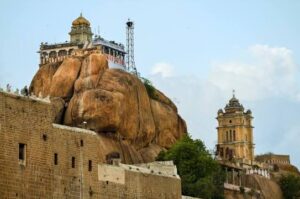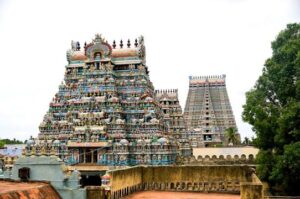Complete Guide about Jambukeshwarar Temple
-
Location
Jambukeswarar Akilandeswari Temple, VP34+674, N Car St, Srirangam, Thiruvanaikoil, Tiruchirappalli, Tamil Nadu 620005
-
Timings
Every Day
06:00am - 01:00 pm 03:00pm - 08:00 pm -
Entry Fee
No Entry fee


Jambukeshwarar Temple
About Jambukeshwarar Temple
In the Tamil Nadu city of Tiruchirupalli, there is a temple dedicated to Jambukeshwar. One of the five panchambootham temples in the nation is the Thiruvanaikal Temple. From the five elements that the Panchambootham symbolise, it stands for water. With His spouse Akhilandeswari Amman, Lord Shiva is the presiding deity in the form of Jambukeswarar. A water stream runs beneath Jambukeswara Temple’s sanctuary sanctorum. Nobody knows where the water that regularly runs beneath the Jala Linga originates from.
All four of the most revered Nayanars (Saivite Saints) have sung the praises of the deity in this temple, making it one of the 275 Paadal Petra Sthalams. Inscriptions from the Chola era can be found in the temple.
Srikalahasti Temple Official Website Link : Click Here
The History
This Jambukeswarar Temple was constructed by Kocengannan, a Chola king, before 1800. (Kochenga Chola). The God Jambukeswarar is depicted in this temple seated beneath a tree that grows into a little water source that submerges the statue during the rainy season. As a result, there is always plenty of water in the temple’s sanctum. There is an underground water channel in this sanctuary that never needs to be manually topped off with water.
One of the five primary Shiva temples in Tamil Nadu that represents the element of water is this one (neer in Tamil language).
Malyavan and Pushpadanta, the two Siva Ganas, are perpetually at odds with one another over a single issue. Malyavan cursed Pushpadanta to transform into an elephant on earth as a result of one fight. Malyavan was also cursed by Pushpadanta to transform into a spider on earth. Following this, the spider and elephant travelled to Jambukeswaram on earth to continue their adoration.
The elephant used to fetch water from the Cauvery River every day and bathe the lingam (Shiva statue) that was located beneath the Jambu tree. The spider would then weave webs over the lingam to shield it from dust and dried leaves. Now, the elephant used to pour water on this spider web daily to tear it. When the spider noticed this, it became enraged and entered the elephant’s trunk to bite it. As a result, the spider and elephant both passed away.
Both of their sincere devotion touched God Shiva, who removed the curse.
This location is known as Thiruvanai Koil or Thiruvanaikaval because elephants were worshipped there. “Thiru” in Tamil means “holy,” and “Aanai” is “elephant.”
Following this, the spider was reborn as King Kochengat Chola as atonement for the sin of killing the elephant. This King, according to Nalayiram Divya Prabandham, erected 70 temples.
This King had constructed a little cloister in this Temple so that not even a small elephant could enter in recollection of his animosity in his previous birth.
The Architecture
In the fourth vicinage, there is a hall with 796 pillars. After that, a small tank with permanent water channels is present. Two gopurams measuring 100 and 73 feet tall, a small water tank, and a coconut thoppu (the Tamil word for “place with many coconut palms”) can be found in the third enclosure. There is a gopuram and numerous little shrines in the second enclosure. The sanctuary is located next inside the enclosure. The shapes of the Pranava manthram “Om” can be seen in the sanctuaries of the god Prasanna Vinayaka and the goddess Akhilandeshwari.
Dekho Apna Desh
The DAD of Tourism
Get Direction to Jambukeshwarar Temple
Near Attractions





